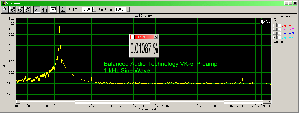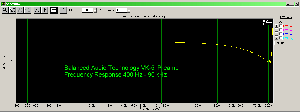You heard in one of our recent blogs that vinyl LP’s are coming back strong. The opinion is that they just sound better than CD’s. I think they do, but would have to put a turntable output vs. CD output on the Audio Precision to find out for sure. And, it would most certainly require a top of the line phono cartridge. Some of those things are thousands of dollars.
Anyway, tube preamps and power amplifiers were all over the place (along with turntables) at the last Rocky Mountain Audio Fest that Cynthia and I attended. I mean, they were everywhere.
Do tubes sound better than solid state? Actually, I asked this question of an amplifier manufacturer in an exhibit room at the first CES I attended about 16 years ago. He said, “Yes.” I said, “Why?” He responded, “I don’t know. No one ever asked me that before.”
Well, to make the long story short, I found out why. Their distortion spectrum is different than solid state. They tend to produce mainly even-ordered harmonics, while solid state can have lots of odd-ordered harmonics. Negative feedback is used in amplifiers to reduce distortion to some degree along with flattening the frequency response, but it can increase the amount of higher order harmonics, such as 5, 7, and 9. Tube amplifiers often use no negative feedback because even-ordered harmonics are not irritating to the ears. Such amplifiers usually have a THD+N specification near or greater than 1%, something that would be considered terrible in typical solid state amplifiers. The frequency response of these no-negative-feedback tube amplifiers is usually not very flat either.
But, the sound is incredible. Take a look at this graph from my BAT VK-5i tube preamplifier (click on it to see the full sized graph, then click the Back arrow to return to the main text). It uses no global negative feedback. Notice that there is only one harmonic, the second (which is an even-ordered harmonic). No upper harmonics at all. Compare that with graphs from various solid state preamplifiers that have been reviewed by all the magazines.
Here is the uppper part of the frequency response of this same preamplifier. It rolls off about 0.2 dB at 20 kHz. This could be improved with the use of negative feedback, but the benefits of not doing this are better than the benefits of doing it.
Now you need to keep in mind that there are some lousy tube amplifiers out there too. Just because tubes can sound good, does not mean they always do. Choice of parts, quality of power supply, and other things make as much difference with tube products as they do with solid state. My VK-5i was $4,500. You get what you pay for with tube components just as you do with solid state.
Frankly, I think the resurgence of LPs and tubes are just because we all like Retro things when they come along. It’s been 25 years since CDs were introduced, so it’s time for LP’s to be retro. Tubes seem to come and go over the years. Right now, they are surely an “in” item. They make wonderful conversation pieces at get togethers. Many youngsters have never seen a tube amplifier. When they do, they immediately want one. My favorite combination is a tube preamplifier with solid state power amplifiers. Guests at my home are always astonished at the sound.
So, there are lots of new tube products out there now. Be sure to listen to one if you get the opportunity.



